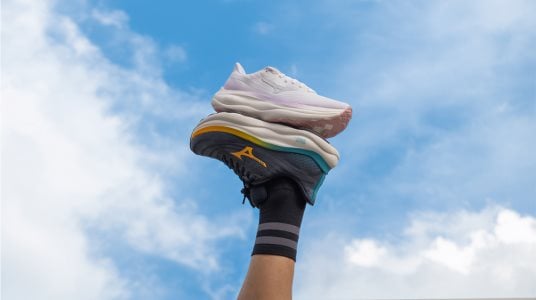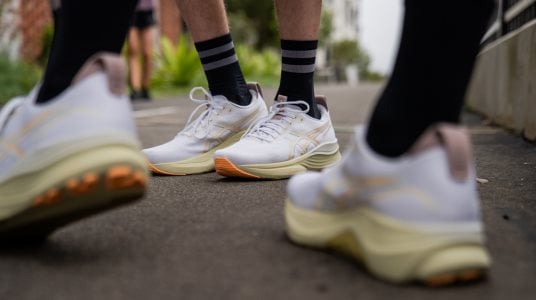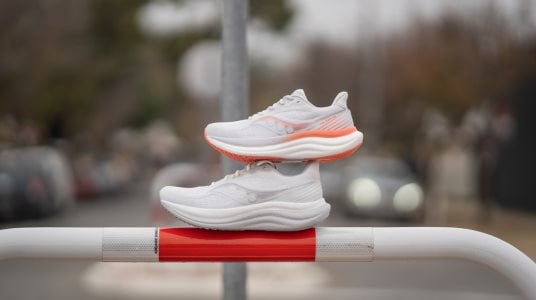The "Daily Trainer" Explained

How do we define a daily trainer?
We like to think of the daily trainer as a workhorse or an all rounder within a shoe rotation and it's generally the shoe you'll be spending most of you runs in!
The daily trainer really focuses on comfort, durability and stability as these shoes shine on easy aerobic runs. You can absolutely do tempo running and speed workouts in them, although there are better options that are designed more specifically for those faster efforts such as the super trainer category. However, if you're wanting just one shoe to cover the majority of the run types in a supportive durable package, a daily trainer is what you'd be after.
While the daily trainer category is a broad umbrella term, there's a lot of variety within it. As running footwear has evolved over the years, brands are emphasising their daily trainers to deliver an 'experience' to the runner. Depending on what type of experience you're wanting from the shoe and your own preferences, daily trainers can differ with the amount of support, cushioning, midsole flexibility and overall weight. As a result some daily trainers can offer more versatility than others.
To simplify this concept, the scales below show how daily trainers can sit within a spectrum of key characteristics to change the experience they offer.

Daily trainers subcategories: max cushioned vs versatile
Max cushion daily training shoes offer an experience with extra softness and cushioning for easy recovery days. These shoes are typically more cushioned, heavier and padded throughout. As a result the scale is biased more towards slow easy running and lacks some of the versatility for faster workouts.
The Asics Nimbus 27 is a great example seen below. Other popular models in this space include the New Balance 1080v14, Brooks Glycerin Max, Puma MagMax, Saucony Triumph 22 and Hoka Bondi 9.

The opposite is true for versatile daily trainers as they are lighter and more nimble than max cushioned shoes. They lean more into the versatile side and offer a faster experience with midsoles that are more responsive; making them more capable for tempo runs and speed workouts. The trade off is that they will tend to be less stable and cushioned for easy runs, compared to the max cushioned category.
The Saucony Endorphin Speed 4 on the scale below is an example of how the experience is different. Other models within this versatile category include the Puma Deviate Nitro 3, Asics Novablast 5, Mizuno Neo Zen, Adidas Boston 12 and Hoka Mach 6.

So what type of daily trainer should you get?
The best daily training running shoe for you depends on your training, goals and personal preferences. If most of your runs are easy aerobic building runs or recovery runs, a max-cushioned daily trainer will provide the plush comfort and impact absorption beneficial to keeping your legs feeling fresh.
However, if your training includes a mixture of easy runs, tempo efforts, and speed workouts, a more versatile daily trainer that balances cushioning, responsiveness and durability is likely the better choice, allowing you to handle different paces with ease.
Ultimately, your preference in terms of how much cushion, stability and versatility you want in your daily trainer should guide your decision. Some runners prefer a softer, more protective feel, while others may enjoy a slightly firmer and more responsive ride for added versatility.

Should I have a shoe rotation?
Having a running shoe rotation isn’t just about having the a shoe for the different types of runs in a typical training week, it's also a great way to improve durability, reduce injury risk, and optimise performance. Running is a high impact sport and by alternating between different shoes, you can distribute that load more effectively across your body, reducing repetitive stress on the same muscles and structures. This can help lower the risk of overuse injuries while also giving your shoes time to decompress between runs to allow the midsole foam to rebound fully, extending the lifespan of each pair.
A balanced rotation typically includes a daily trainer, possibly a super trainer for faster efforts and long runs and then a carbon plated race day shoe, with each having a distinct role. Daily trainers handle most of your mileage with reliable cushioning and durability, helping your legs recover between harder sessions. Meanwhile, super trainers, often featuring high-energy foam and propulsive designs, allow you to push the pace during workouts and long runs. When race day arrives, your dedicated racing shoe feels even lighter and more responsive, making the transition seamless. By strategically rotating between different types of shoes, you not only extend their longevity but also optimise your performance and comfort across all types of runs.

About the author
Nathan Pope - Runner and Shoe Nerd
I'm really passionate about running footwear and how shoes can be used as a tool to get the best of your running, whether that be general fitness or performance.
My favourite event is the marathon. I feel as though the marathon is the ultimate test both physically and mentally! It requires careful planning both within the race and during the training block and it can be super satisfying when it comes together on race day.


